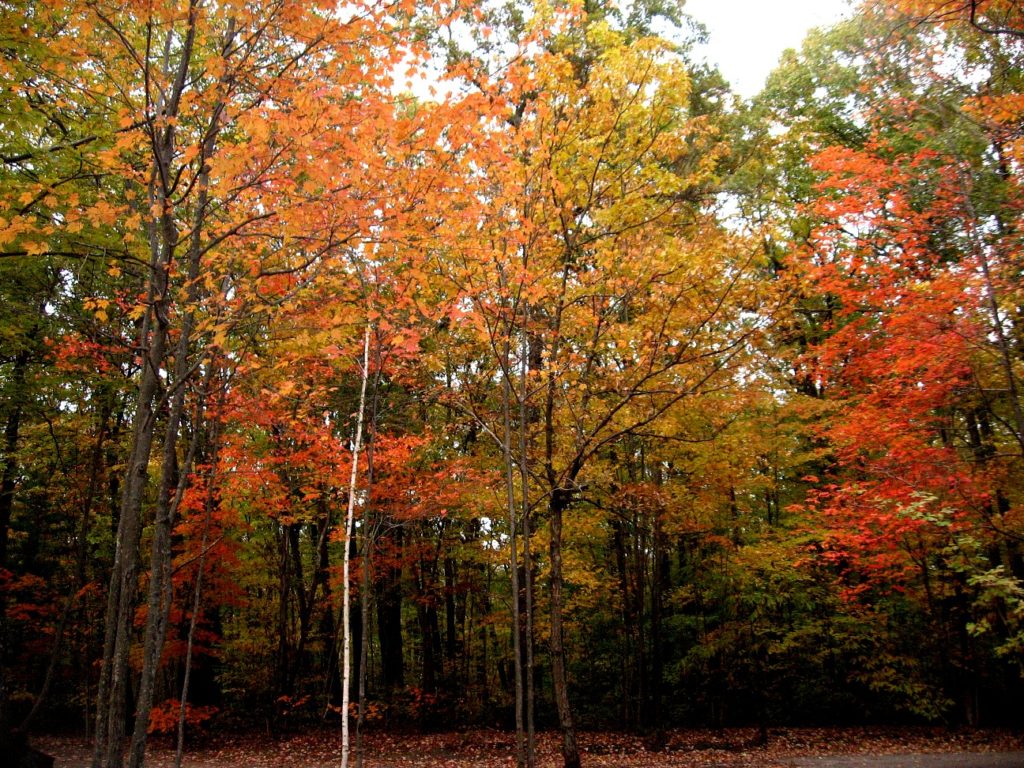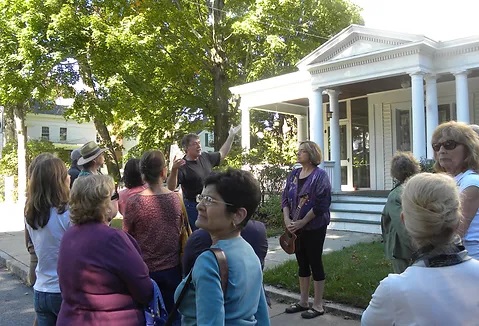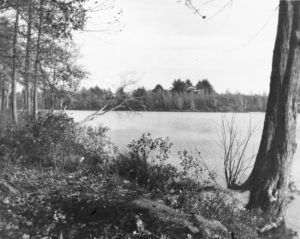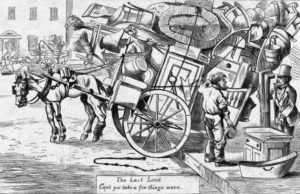
The following essay inaugurates a new Westborough History Connections series called, “A Meeting of Two Cultures: Native Americans and the English in Westborough.”
Seasonal Change and the Meeting of Two Cultures
The shocks of short-lived color in the trees, the sudden appearance of refreshingly cooler breezes, the noticeable decrease of sunlight in the evenings, and the quick rush to prepare for hibernation before winter truly sets in. Fall in New England makes me think about the rhythms of seasonal change more than any other season, perhaps because it is a brief, but decisive, end to the rich greenery that we have been enjoying for so long.
I grew up in the Midwest and have always seen seasonal change as an important marker of time. How odd it must be, I would wonder, to live in a place where the leaves on the trees did not turn color or where snow never hit the ground. How would people know that time is moving along if they didn’t have such annual markers to remind them? But then a friend from southern California once remarked to me while we were both graduate students on Long Island that, for her, the seasons in the Northeast made time stand still. The seasons created boxes of time, where behaviors during that particular time-span were repeated over and over again each year to the point where time never seems to move forward. (“Didn’t we just go apple-picking last year?”) She missed a lifestyle that is not regularly upended by seasonal change, where the ever-distant time horizon seems to open up endless opportunities.
In many ways, seasonal change makes New England, well, New England. Over the years, we have developed certain behaviors that track along with the changing environment in which we live. Today, we tend to think of such behaviors in semi-nostalgic terms. We engage in apple-picking, pumpkin carving, and “leaf-peeping” (a term that for some reason makes me slightly uncomfortable) more because they connect us to our environment and to our ideas of the past than out of necessity—and because they are fun. But if you are living off the land itself, tracking seasonal change and adapting behaviors accordingly becomes imperative.
In Changes in the Land: Indians, Colonists, and the Ecology of New England, William Cronon nicely sums up this idea, an idea that becomes rather complicated once necessity enters the picture:
A central fact of temperate ecosystems like those of New England is their periodicity: they are tied to overlapping cycles of light and dark, high and low tides, waxing and waning moons, and especially the long and short days which mean hot and cold seasons. Each plant and animal species makes its adjustments to these various cycles, so that the flowing of sap in trees, the migration of birds, the spawning of fish, the rutting of deer, and the fruiting of plants all have their special times of the year. A plant that stores most of its food energy in its roots during the winter will transfer much of that energy first to its leaves and then to its seeds as the warmer months progress. Such patterns of energy concentration are crucial to any creature which seeks to eat that plant. Because animals, including people, feed on plants and other animals, the ways they obtain their food are largely determined by the cycles in which other species lead their lives. Just as a fox’s summer diet of fruit and insects shifts to rodents and birds during the winter, so too did the New England Indians seek to obtain their food wherever it was seasonally most concentrated in the New England ecosystem. Doing so required an intimate understanding of the habits and ecology of other species, and it was this knowledge that the English discovered they lacked (37).
When the English first arrived here in New England, they assumed that they could simply set up life as they knew it back in England; in other words, they brought with them the adaptations that they had developed over time in Europe and assumed that they would work here in North America. Their ideas about agriculture and food production were premised on changing the land to suit their own European diets and needs, rather than on taking advantage of the bounty that the environment naturally offered and adapting their behaviors to it. Native Americans had learned how to make nature work for them; their behaviors and lifestyles were designed over time to follow the rhythms of seasonal change. Their situation was not unique: it is how human beings have generally lived throughout our time here on earth, no matter where we happen to live. Such adaptations, however, take time.
I find the meeting of Native Americans and the English—two cultures with different sets of ideas about how to interact within the environment that they were given—to be fascinating. In this regard, Native Americans had the advantage over Europeans by having lived in North America over thousands of years. The English, however, were determined to imprint the structures they had developed in Europe onto the North American landscape. Doing so turned out to be more challenging than they had imagined. My friend from California discovered when she moved to the Northeast that she could not bring with her a notion that seems so basic as the experience of time; since I was from the Midwest, which has similar seasonal variation as the Northeast, I had an easier time adjusting to my new environment.
The organization of our material environment—both ecologically and the structures we create to function within that natural system—work to form our social behaviors. We cannot understand the meeting of Native Americans and Europeans without a knowledge of how each structured their material environment and how those structures created different social attitudes and behaviors. These two differing frameworks guided the actions and reactions of the respective groups here in New England as they struggled to find an equilibrium for living together over the course of the seventeenth and eighteenth centuries. Needless to say, they never found such an equilibrium, and we still feel the repercussions of that outcome today.
In upcoming newsletters, I am going to be exploring this meeting of two cultures, a meeting that created as much of a fundamental shift in how human beings populated North America as the seasonal turning point from Summer to Winter. My ultimate goal will be to bring more nuance and sophistication to our understanding of the early history of the area in and around Westborough.
—Anthony Vaver, Local History Librarian
Works Consulted:
* * *

Downtown Architectural Walking Tour with Music
Sunday, October 30, 1:00 p.m. starting on West Main Street in front of Westborough TV by preservationist Chris Noonan, folk singer Luanne Crosby, and special guests. FREE.
This walk will cover culturally important and historic areas downtown—buildings, landscapes, structures, monuments, and cemeteries—that were planned, designed and/or constructed before 1970. Along the tour, the three basic categories of the Community Preservation Act (CPA)—affordable housing, historic preservation and open space/recreation—will be discussed and viewed from the public way. Site-specific potential projects will be visited using visioning techniques, where we will imagine what might be possible at each site. Various Town officials will share their expertise and experiences in the three areas along the route.
* * *

“The Truth Behind the Tales – The Nipmuc Presence in Westborough.”
Monday, November 7 at 7:00 p.m. on Zoom. Sponsored by the Westborough Historical Society.
Cheryll Toney Holley, Leader of the Hassanamisco Nipmuc Band in Grafton, will talk about Nipmuc tribal oral history, especially Westborough’s Nipmuc stories, and will uncover the historic basis and Nipmuc perspectives behind each story. Free on Zoom.
Please register using this link: https://us02web.zoom.us/meeting/register/tZMucOioqD4iG9QwD6l5GVSscMkAfgbi-tGG
* * *
Tell Us Your Westborough Story
We are starting a new annual feature that we will add content to the Westborough Archive called, “Your Westborough Story.” This year, share your thoughts and memories by answering the question: “What Brought You to Westborough?” (and if you never left Westborough, tell us why you have stayed!). Click on the link to tell your story or stop by the Westborough Center and fill out a paper form. Your contribution will go into the Westborough Archive and become a part of Westborough history!
* * *
Did you enjoy reading this Westborough Center Pastimes newsletter? Then subscribe by e-mail and have the newsletter and other notices from the Westborough Center for History and Culture at the Westborough Public Library delivered directly to your e-mail inbox.
You can also read the current and past issues on the Web by clicking here.

